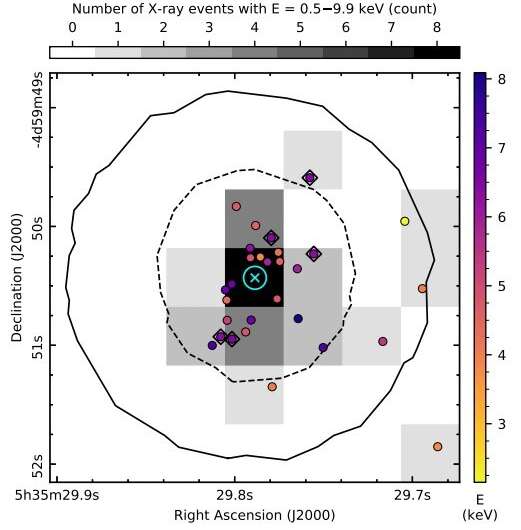June 11, 2020 report
Powerful X-ray flare detected from the protostar HOPS 383

Using NASA's Chandra X-ray Observatory and the Southern Astrophysical Research (SOAR) telescope, astronomers have conducted X-ray observations and near-infrared imaging of a protostar named HOPS 383. The monitoring campaign detected a powerful X-ray flare from the source, which could help astronomers to better understand the earliest stages of star formation. The finding is detailed in a paper accepted for publication in Astronomy and Astrophysics, and posted June 4 on arXiv.org.
The so-called Class 0 objects are the youngest accreting protostars, representing the earliest evolutionary stage of solar-type stars. Given that hydrostatic core in Class 0 protostars is deeply embedded within its envelope and molecular cloud, such objects are difficult to observe at most wavelengths. Therefore, some questions regarding their nature remain unanswered.
For instance, researchers still debate whether or not magnetic activity is present in Class 0 protostars. X-ray observations of these objects could verify this as X-rays are key signature of magnetic activity in more evolved protostars and young stars.
So a team of astronomers led by Nicolas Grosso of the French National Centre for Scientific Research performed X-ray observations of HOPS 383—a Class 0 protostar in the Orion Molecular Cloud 3. The object attracted the attention of researchers as it is the first Class 0 protostar known to have undergone a mass-accretion-driven eruption, which peaked by 2008 and ended by September 2017.
"We observed HOPS 383 three times with the Chandra X-ray Observatory from December 13 to 14, 2017 with simultaneous near-infrared imaging on December 14, 2017, using the 4.1 m Southern Astrophysical Research (SOAR) telescope in Chile," the astronomers wrote in the paper.
The observations recorded a powerful X-ray flare from HOPS 383 lasting about 3.3 hours. By analyzing the evolution of the flare, the researchers found that the count rate reached its peak nearly 0.9 hours after the first photon detection, and then decayed gradually in some 2.5 hours until the last photon detection. The researchers noted that such rapid rise and slow decay is typical for magnetic flares from young stellar objects (YSOs).
The X-ray luminosity of the flare reached about 42 nonillion erg/s in the 2–8 keV energy band at its peak. This is more than 20 times greater than the luminosity of the source's quiescent level.
Moreover, the study found the spectrum of the flare is highly absorbed and displays a 6.4 keV emission line with a width of about 1.1 keV, arising from neutral or low-ionization iron. The astronomers say that the iron line width is relatively large compared to what is expected from possible emission processes.
The researchers estimated the flare's hot plasma temperature to be approximately 4.1 keV. This result is consistent with a magnetic flare and the photoionization of iron.
All in all, the authors of the paper concluded that strong magnetic activity is present in HOPS 383. "The detection of a powerful X-ray flare from HOPS 383 constitutes direct proof that magnetic activity can be present at the earliest formative stages of solar-type stars," the astronomers wrote.
More information: Grosso et. al. Evidence for magnetic activity at starbirth: a powerful X-ray flare from the Class 0 protostar HOPS 383, arXiv:2006.02676 [astro-ph.HE] arxiv.org/abs/2006.02676
© 2020 Science X Network





















